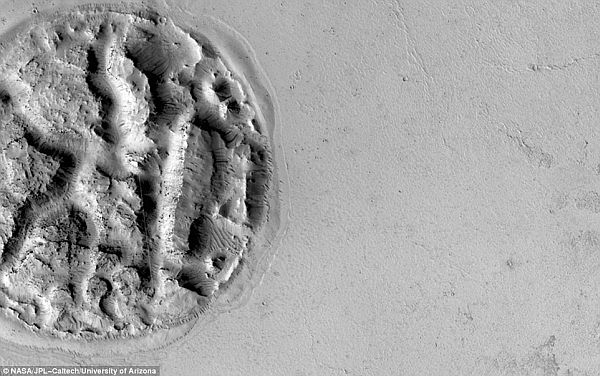Recent image received by NASA clarifies the fact that once the Martian surface was saturated by volcanoes. The image has a semblance of a human brain (pictured above) and it stretches over a distance of approximately 1.2 miles. The agency has called it the ‘circular island’ since it appears to be an island encircled by smoothly flowing magma.
The unique shape has been discovered in Athabasca area, the same region is noted for youngest volcanic flows on the planet Mars meaning thereby that volcanism might be responsible for creating the impression, claimed the NASA experts.
This is not the only impression that the organization has received so far rather there have been an array of similar features, which continues to puzzle the space researchers.
HiRISE
HiRISE (High Resolution Imaging Science Experiment) one of six science instruments for NASA’s Mars Reconnaissance Orbiter has been reflecting back the images from the Martian surface to which the researchers are studying for further inspection to get more clues with respect to the formation of such islands. Even the high-resolution pictures from the HiRISE camera have been noted for similar isle surrounded by smooth flowing lava material.
Lunar and Planetary Laboratory at the University of Arizona have developed the camera. It weighs 65 kg and cost around $40 million. Like the human eyes, the camera too functions in visible wavelengths; however, the telescopic lens delivers high-resolution pictures of the surface structures that previously have never been reported from any planetary exploration missions.
During the near-infrared wavelengths, the camera is able to take observation for gathering information regarding mineral groups present. Not only the camera has an ability of taking high-resolution stills of material depositions, gullies and channels on the Martian surface, it can also take pictures of possible future landing sites.
The island is an epitome of Late Amazonian Age. The surface of Athabasca area has been saturated with numerous small cones and rings that are an offshoot of magma once surged the region. Since presently, the area is very much covered with lava flow, hence determining the age of the water floods that once occupied the area is not an easy task.
Source: [Jet Propulsion Laboratory] [Daily Mail]





